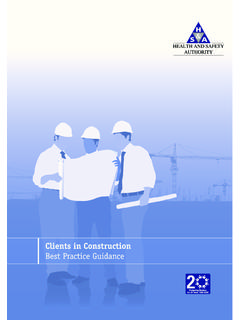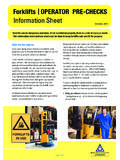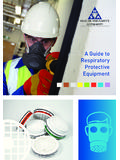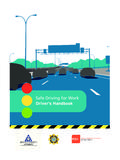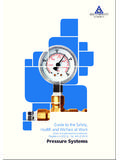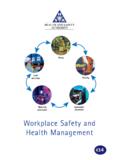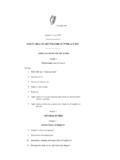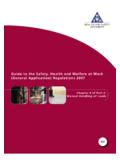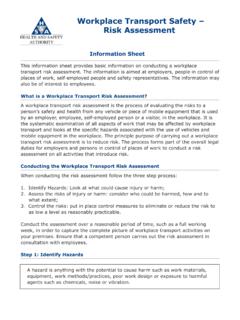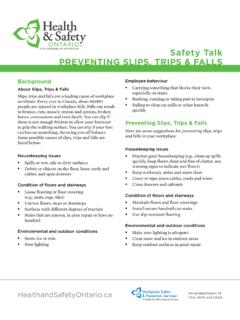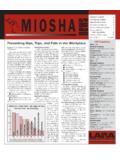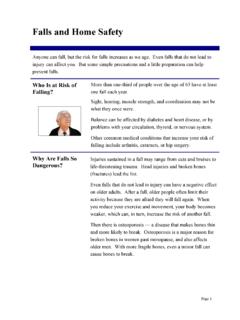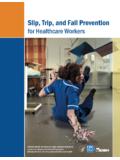Transcription of “Watch Your Step” - Home - Health and Safety …
1 Information SheetEvery working day in Ireland six people are hurt in work-related Slips, Trips and Falls (STF). STF are the second greatest single cause of workplace injuries. Over the years, many STF have tragically been fatal. A greater percentage of STF (than all other accidents) result in absences from work of one month or more. This information sheet will help you understand how to control work-related STF. What does the law require? The Safety , Health and Welfare at Work Act requires: safe access, safe systems of work, training, risk assessment, and a Safety Application Regulations require pedestrian surfaces to be: clean, fixed, stable, not slippery, and without dangerous bumps, holes or slopes.
2 100%Magenta 76%Yellow 0 Black 27%1 of 4 preventing Slips, Trips and Falls at Work Factors in work-related slips, trips and falls Slips account for about half of all slips, trips and falls. Factors in work-related slips, trips and falls include:-A butcher slipped on blood and accidentally started a machine with one hand. His other hand was caught in the closing blade. The machine operated because a critical safeguard did not work. Two fingers were amputated and another partially amputated on his dominant right 2017 Watch Your Step Butcher Slip Case StudyStairs, StepsSlippery WetSurfaces*VehiclesWalkwaysIce*UnevenSu rfacesCleaning*Entrances,ExitsDescending stairs, stepsExitingVehiclesFigure 1: Factors in Work Slips, Trips and FallsSlips, Trips and Falls (STF) Factors*Over 80% were slips Watch Your Step - preventing Slips, Trips and Falls at Work Information Sheet2 of 4 Stairs and steps Every working day one person in Ireland is hurt in a STF on stairs and steps at work.
3 Descending stairs and steps is a significant factor in accidents. A slip on stairs or steps can be caused by inadequate support for the ball of the foot, as well as a slippery wet interdependent key elements of work stairs and steps Safety are discussed in the Safer Work Stairs and Steps webpage and detailed in our Safer Work Stairs and Steps Information Sheet at 1. Operational Controls use rules and policies to prevent accidents, for example, by prohibiting hazardous activities. Implement good practices, for example, by showing the location of lifts, the use of handrails.
4 Control problem steps or stairs, for example, by highlighting short or irregular steps. 2. Environmental Controls remove distractions like posters. Provide visual cues, such as lighting and provide contrasting step edges or nosings and contrasting 2: Key elements of work stairs and steps safetySlippery surfaces Slips account for almost half of all STF. The other half are trips, falls and other STF accidents such as missteps. People generally slip on level surfaces when these surfaces are wet or contaminated. For new surfaces, you should consult our advice at the Selecting Surfaces webpage at before selecting/ installing new surfaces.
5 For existing surfaces, you must check the condition of the surface and rectify slippery surfaces. See the advice in our Slippery Surfaces webpage. 1. Identification - map and identify areas where a slip risk exists. If in doubt, arrange for a measurement of actual Operational Controls - deep clean to attempt to restore slip resistance. Control spills and try to prevent them. Use mats to prevent slips. Use slip-resistant footwear if needed. Communicate risks, including warnings and properly used signs. 3. Structural Changes - change the surface to a slip-resistant one. It may be possible to treat the surface to make it slip-resistant (using abrasive treatments, coatings, acid etching, strips, films).
6 The risk of slips can be reduced by improving EnvironmentalControls1. OperationalControls3. HazardousStepsNo mobile devices4. HandrailUse lift at if going downNo carrying itemson stairsMind thestepHIGH RISKNo supportMEDIUM RISKSome supportIrregularsteps1. Get envelope, A4 ream or similarPower Grip2. Mark rise and going of bottom step3. Check all steps for differencesCrouch-and-sightRegular StepsIrregular StepIrregular Step(relevant location)2. EnvironmentalControls1. OperationalControls3. HazardousStepsNo mobile devices4. HandrailUse lift at if going downNo carrying itemson stairsMind thestepHIGH RISKNo supportMEDIUM RISKSome supportIrregularsteps1.
7 Get envelope, A4 ream or similarPower Grip2. Mark rise and going of bottom step3. Check all steps for differencesCrouch-and-sightRegular StepsIrregular StepIrregular Step(relevant location)Figure 3: Key elements in level work slips3. Pedestrian1. SlipperySurface2. Contamination3. Hazardous Steps identify hazardous steps (with workplace checks). Eliminate where possible, or control, slippery, surprise, short and irregular Handrail(s) provide properly sited, contrasting handrail(s) that permit a power grip. Watch Your Step - preventing Slips, Trips and Falls at Work Information Sheet3 of 4 VehiclesVehicle-related slips, trips and falls are important across all work sectors, not just the transport sector.
8 Exiting vehicles was a factor in almost half of all vehicle STF work injuries. Significant factors and important controls are mentioned below, listed on our Vehicles STF webpage and detailed in our Vehicle Slips, Trips and Falls Information Sheet. 1. Entering and exiting vehicles find a safe parking space and check ground conditions. Remember, Open the door, check the floor .2. Vehicle steps maintain slip-resistant vehicle steps in good condition and use three points of contact or Slip-resistant footwear provide, wear, and maintain slip-resistant Vehicle walk-on surfaces - provide slip-resistant walk-on surfaces and keep them clean and tidy.
9 Advice on Metal and Profiled Surfaces is available at Risk areas implement controls at risk areas including uneven ground, vehicle cabs, platforms and load areas, 5th wheel areas of HGVs, vehicle steps and ladders, tail lifts and tanker ConditionsCold icy weather can double the number of slips, trips and falls. December and January are high risk periods. You should plan and implement the WALCS control system detailed in our Ice Slips and Falls web section at Weather monitor weather conditions using resources such as Met ireann snow or ice or low temperature Activities take great care if walking on ice and wear the correct footwear (spikes or studs).
10 Be aware of the advice for driving (such as avoiding unnecessary trips) and for clearing snow and ice. 3. Locations consider high-risk locations such as third-party premises, car parks, external pedestrian areas and Communication ensure two-way communication to advise staff of hazards and allow them to notify changing conditions. 5. Sample Dynamic Risk Assessment continually assess the working conditions and activities and ensure that your control measures are cleaning Wet floor cleaning causes slips. The people who slip are generally not Cleaners and Helpers but other persons at the workplace.
